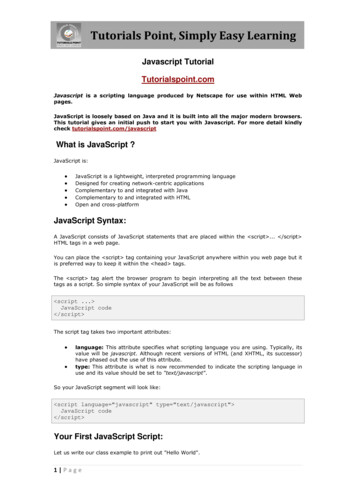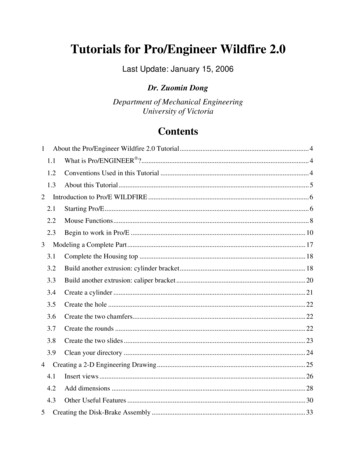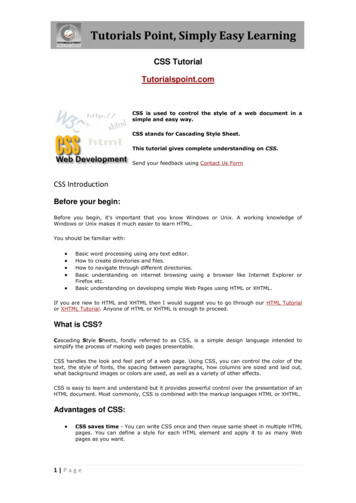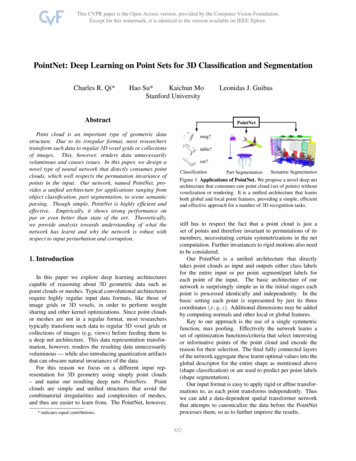
Transcription
Tutorials Point, Simply Easy LearningJavascript TutorialTutorialspoint.comJavascript is a scripting language produced by Netscape for use within HTML Webpages.JavaScript is loosely based on Java and it is built into all the major modern browsers.This tutorial gives an initial push to start you with Javascript. For more detail kindlycheck tutorialspoint.com/javascriptWhat is JavaScript ?JavaScript is: JavaScript is a lightweight, interpreted programming languageDesigned for creating network-centric applicationsComplementary to and integrated with JavaComplementary to and integrated with HTMLOpen and cross-platformJavaScript Syntax:A JavaScript consists of JavaScript statements that are placed within the script . /script HTML tags in a web page.You can place the script tag containing your JavaScript anywhere within you web page but itis preferred way to keep it within the head tags.The script tag alert the browser program to begin interpreting all the text between thesetags as a script. So simple syntax of your JavaScript will be as follows script . JavaScript code /script The script tag takes two important attributes: language: This attribute specifies what scripting language you are using. Typically, itsvalue will be javascript. Although recent versions of HTML (and XHTML, its successor)have phased out the use of this attribute.type: This attribute is what is now recommended to indicate the scripting language inuse and its value should be set to "text/javascript".So your JavaScript segment will look like: script language "javascript" type "text/javascript" JavaScript code /script Your First JavaScript Script:Let us write our class example to print out "Hello World".1 Page
Tutorials Point, Simply Easy Learning html body script language "javascript" type "text/javascript" !-document.write("Hello World!")//-- /script /body /html Above code will display following result:Hello World!Whitespace and Line Breaks:JavaScript ignores spaces, tabs, and newlines that appear in JavaScript programs.Because you can use spaces, tabs, and newlines freely in your program so you are free toformat and indent your programs in a neat and consistent way that makes the code easy toread and understand.Semicolons are Optional:Simple statements in JavaScript are generally followed by a semicolon character, just as theyare in C, C , and Java. JavaScript, however, allows you to omit this semicolon if yourstatements are each placed on a separate line. For example, the following code could be writtenwithout semicolons script language "javascript" type "text/javascript" !-var1 10var2 20//-- /script But when formatted in a single line as follows, the semicolons are required: script language "javascript" type "text/javascript" !-var1 10; var2 20;//-- /script Note: It is a good programming practice to use semicolons.Case Sensitivity:JavaScript is a case-sensitive language. This means that language keywords, variables, functionnames, and any other identifiers must always be typed with a consistent capitalization of letters.So identifiers Time, TIme and TIME will have different meanings in JavaScript.NOTE: Care should be taken while writing your variable and function names in JavaScript.2 Page
Tutorials Point, Simply Easy LearningComments in JavaScript:JavaScript supports both C-style and C -style comments, Thus: Any text between a // and the end of a line is treated as a comment and is ignored byJavaScript.Any text between the characters /* and */ is treated as a comment. This may spanmultiple lines.JavaScript also recognizes the HTML comment opening sequence !--. JavaScript treatsthis as a single-line comment, just as it does the // comment.The HTML comment closing sequence -- is not recognized by JavaScript so it shouldbe written as //-- .JavaScript Placement in HTML File:There is a flexibility given to include JavaScript code anywhere in an HTML document. But thereare following most preferred ways to include JavaScript in your HTML file. ScriptScriptScriptScriptinininin head . /head section. body . /body section. body . /body and head . /head sections.and external file and then include in head . /head section.JavaScript DataTypes:JavaScript allows you to work with three primitive data types: Numbers eg. 123, 120.50 etc.Strings of text e.g. "This text string" etc.Boolean e.g. true or false.JavaScript also defines two trivial data types, null and undefined, each of which defines only asingle value.JavaScript Variables:Like many other programming languages, JavaScript has variables. Variables can be thought ofas named containers. You can place data into these containers and then refer to the data simplyby naming the container.Before you use a variable in a JavaScript program, you must declare it. Variables are declaredwith the var keyword as follows: script type "text/javascript" !-var money;var name;//-- /script JavaScript Variable Scope:The scope of a variable is the region of your program in which it is defined. JavaScript variablewill have only two scopes.3 Page
Tutorials Point, Simply Easy Learning Global Variables: A global variable has global scope which means it is definedeverywhere in your JavaScript code.Local Variables: A local variable will be visible only within a function where it isdefined. Function parameters are always local to that function.JavaScript Variable Names:While naming your variables in JavaScript keep following rules in mind. You should not use any of the JavaScript reserved keyword as variable name. Thesekeywords are mentioned in the next section. For example, break or boolean variablenames are not valid.JavaScript variable names should not start with a numeral (0-9). They must begin witha letter or the underscore character. For example, 123test is an invalid variable namebut 123test is a valid one.JavaScript variable names are case sensitive. For example, Name and name are twodifferent variables.JavaScript Reserved Words:The following are reserved words in JavaScript. They cannot be used as JavaScript variables,functions, methods, loop labels, or any object truetrytypeofvarvoidvolatilewhilewithThe Arithmatic Operators:There are following arithmatic operators supported by JavaScript language:Assume variable A holds 10 and variable B holds 20 then:OperatorDescriptionExample Adds two operandsA B will give 30-Subtracts second operand from the firstA - B will give -10*Multiply both operandsA * B will give 200/Divide numerator by denumeratorB / A will give 2%Modulus Operator and remainder of after aninteger divisionB % A will give 04 Page
Tutorials Point, Simply Easy Learning Increment operator, increases integer value by one A will give 11--Decrement operator, decreases integer value byoneA-- will give 9The Comparison Operators:There are following comparison operators supported by JavaScript languageAssume variable A holds 10 and variable B holds 20 then:OperatorDescriptionExample Checks if the value of two operands are equal ornot, if yes then condition becomes true.(A B) is not true.! Checks if the value of two operands are equal ornot, if values are not equal then condition becomestrue.(A ! B) is true. Checks if the value of left operand is greater thanthe value of right operand, if yes then conditionbecomes true.(A B) is not true. Checks if the value of left operand is less than thevalue of right operand, if yes then conditionbecomes true.(A B) is true. Checks if the value of left operand is greater thanor equal to the value of right operand, if yes thencondition becomes true.(A B) is not true. Checks if the value of left operand is less than orequal to the value of right operand, if yes thencondition becomes true.(A B) is true.The Logical Operators:There are following logical operators supported by JavaScript languageAssume variable A holds 10 and variable B holds 20 then:OperatorDescriptionExample&&Called Logical AND operator. If both the operandsare non zero then then condition becomes true.(A && B) is true. Called Logical OR Operator. If any of the twooperands are non zero then then conditionbecomes true.(A B) is true.!Called Logical NOT Operator. Use to reverses thelogical state of its operand. If a condition is truethen Logical NOT operator will make false.!(A && B) is false.The Bitwise Operators:There are following bitwise operators supported by JavaScript language5 Page
Tutorials Point, Simply Easy LearningAssume variable A holds 2 and variable B holds 3 then:OperatorDescriptionExample&Called Bitwise AND operator. It performs a Boolean (A & B) is 2 .AND operation on each bit of its integerarguments. Called Bitwise OR Operator. It performs a BooleanOR operation on each bit of its integer arguments.(A B) is 3. Called Bitwise XOR Operator. It performs aBoolean exclusive OR operation on each bit of itsinteger arguments. Exclusive OR means that eitheroperand one is true or operand two is true, but notboth.(A B) is 1. Called Bitwise NOT Operator. It is a is a unaryoperator and operates by reversing all bits in theoperand.( B) is -4 . Called Bitwise Shift Left Operator. It moves all bitsin its first operand to the left by the number ofplaces specified in the second operand. New bitsare filled with zeros. Shifting a value left by oneposition is equivalent to multiplying by 2, shiftingtwo positions is equivalent to multiplying by 4, etc.(A 1) is 4. Called Bitwise Shift Right with Sign Operator. It(A 1) is 1.moves all bits in its first operand to the right bythe number of places specified in the secondoperand. The bits filled in on the left depend on thesign bit of the original operand, in order topreserve the sign of the result. If the first operandis positive, the result has zeros placed in the highbits; if the first operand is negative, the result hasones placed in the high bits. Shifting a value rightone place is equivalent to dividing by 2 (discardingthe remainder), shifting right two places isequivalent to integer division by 4, and so on. Called Bitwise Shift Right with Zero Operator. Thisoperator is just like the operator, except thatthe bits shifted in on the left are always zero,(A 1) is 1.The Assignment Operators:There are following assignment operators supported by JavaScript language:OperatorDescriptionExample Simple assignment operator, Assigns values fromright side operands to left side operandC A B will assigne value ofA B into C Add AND assignment operator, It adds rightoperand to the left operand and assign the resultto left operandC A is equivalent to C C A- Subtract AND assignment operator, It subtractsright operand from the left operand and assign theresult to left operandC - A is equivalent to C C A* Multiply AND assignment operator, It multipliesC * A is equivalent to C C *6 Page
Tutorials Point, Simply Easy Learningright operand with the left operand and assign theresult to left operandA/ Divide AND assignment operator, It divides leftoperand with the right operand and assign theresult to left operandC / A is equivalent to C C /A% Modulus AND assignment operator, It takesmodulus using two operands and assign the resultto left operandC % A is equivalent to C C%AMiscellaneous OperatorThe Conditional Operator (? :)There is an oprator called conditional operator. This first evaluates an expression for a true orfalse value and then execute one of the two given statements depending upon the result of theevaluation. The conditioanl operator has this syntax:Operator?:DescriptionConditional ExpressionExampleIf Condition is true ? Then value X :Otherwise value YThe typeof OperatorThe typeof is a unary operator that is placed before its single operand, which can be of anytype. Its value is a string indicating the data type of the operand.The typeof operator evaluates to "number", "string", or "boolean" if its operand is a number,string, or boolean value and returns true or false based on the evaluation.if statement:The if statement is the fundamental control statement that allows JavaScript to make decisionsand execute statements conditionally.Syntax:if (expression){Statement(s) to be executed if expression is true}if.else statement:The if.else statement is the next form of control statement that allows JavaScript to executestatements in more controlled way.Syntax:if (expression){Statement(s) to be executed if expression is true}else{Statement(s) to be executed if expression is false}7 Page
Tutorials Point, Simply Easy Learningif.else if. statement:The if.else if. statement is the one level advance form of control statement that allowsJavaScript to make correct decision out of several conditions.Syntax:if (expression 1){Statement(s) to be executed}else if (expression 2){Statement(s) to be executed}else if (expression 3){Statement(s) to be executed}else{Statement(s) to be executed}if expression 1 is trueif expression 2 is trueif expression 3 is trueif no expression is trueswitch statement:The basic syntax of the switch statement is to give an expression to evaluate and severaldifferent statements to execute based on the value of the expression. The interpreter checkseach case against the value of the expression until a match is found. If nothing matches, adefault condition will be used.switch (expression){case condition 1: statement(s)break;case condition 2: statement(s)break;.case condition n: statement(s)break;default: statement(s)}The while LoopThe most basic loop in JavaScript is the while loop which would be discussed in this tutorial.Syntax:while (expression){Statement(s) to be executed if expression is true}The do.while Loop:The do.while loop is similar to the while loop except that the condition check happens at theend of the loop. This means that the loop will always be executed at least once, even if thecondition is false.Syntax:8 Page
Tutorials Point, Simply Easy Learningdo{Statement(s) to be executed;} while (expression);The for LoopThe for loop is the most compact form of looping and includes the following three importantparts: The loop initialization where we initialize our counter to a starting value. Theinitialization statement is executed before the loop begins.The test statement which will test if the given condition is true or not. If condition istrue then code given inside the loop will be executed otherwise loop will come out.The iteration statement where you can increase or decrease your counter.You can put all the three parts in a single line separated by a semicolon.Syntax:for (initialization; test condition; iteration statement){Statement(s) to be executed if test condition is true}The for.in Loopfor (variablename in object){statement or block to execute}In each iteration one property from object is assigned to variablename and this loop continuestill all the properties of the object are exhausted.The break Statement:The break statement, which was briefly introduced with the switch statement, is used to exit aloop early, breaking out of the enclosing curly braces.The continue Statement:The continue statement tells the interpreter to immediately start the next iteration of the loopand skip remaining code block.When a continue statement is encountered, program flow will move to the loop checkexpression immediately and if condition remain true then it start next iteration otherwise controlcomes out of the loop.Function Definition:Before we use a function we need to define that function. The most common way to define afunction in JavaScript is by using the function keyword, followed by a unique function name, alist of parameters (that might be empty), and a statement block surrounded by curly braces.The basic syntax is shown here: script type "text/javascript" 9 Page
Tutorials Point, Simply Easy Learning !-function functionname(parameter-list){statements}//-- /script Calling a Function:To invoke a function somewhere later in the script, you would simple need to write the name ofthat function as follows: script type "text/javascript" !-sayHello();//-- /script ExceptionsExceptions can be handled with the common try/catch/finally block structure. script type "text/javascript" !-try {statementsToTry} catch ( e ) {catchStatements} finally {finallyStatements}//-- /script The try block must be followed by either exactly one catch block or one finally block (or one ofboth). When an exception occurs in the catch block, the exception is placed in e and the catchblock is executed. The finally block executes unconditionally after try/catch.Alert Dialog Box:An alert dialog box is mostly used to give a warning message to the users. Like if one input fieldrequires to enter some text but user does not enter that field then as a part of validation youcan use alert box to give warning message as follows: head script type "text/javascript" !-alert("Warning Message");//-- /script /head 10 P a g e
Tutorials Point, Simply Easy LearningConfirmation Dialog Box:A confirmation dialog box is mostly used to take user's consent on any option. It displays adialog box with two buttons: OK and Cancel.You can use confirmation dialog box as follows: head script type "text/javascript" !-var retVal confirm("Do you want to continue ?");if( retVal true ){alert("User wants to continue!");return true;}else{alert("User does not want to continue!");return false;}//-- /script /head Prompt Dialog Box:You can use prompt dialog box as follows: head script type "text/javascript" !-var retVal prompt("Enter your name : ", "your name here");alert("You have entered : " retVal );//-- /script /head Page Re-directionThis is very simple to do a page redirect using JavaScript at client side. To redirect your sitevisitors to a new page, you just need to add a line in your head section as follows: head script type "text/javascript" !-window.location "http://www.newlocation.com";//-- /script /head The void Keyword:The void is an important keyword in JavaScript which can be used as a unary operator thatappears before its single operand, which may be of any type.This operator specifies an expression to be evaluated without returning a value. Its syntax couldbe one of the following:11 P a g e
Tutorials Point, Simply Easy Learning head script type "text/javascript" !-void func()javascript:void func()or:void(func())javascript:void(func())//-- /script /head The Page Printing:JavaScript helps you to implement this functionality using print function of window object.The JavaScript print function window.print() will print the current web page when executed.You can call this function directly using onclick event as follows: head script type "text/javascript" !-//-- /script /head body form input type "button" value "Print" onclick "window.print()" / /form /body Storing Cookies:The simplest way to create a cookie is to assign a string value to the document.cookie object,which looks like this:Syntax:document.cookie "key1 value1;key2 value2;expires date";Reading Cookies:Reading a cookie is just as simple as writing one, because the value of the document.cookieobject is the cookie. So you can use this string whenever you want to access the cookie.The document.cookie string will keep a list of name value pairs separated by semicolons, wherename is the name of a cookie and value is its string value.JavaScript - Page RedirectionWhat is page redirection ?12 P a g e
Tutorials Point, Simply Easy LearningWhen you click a URL to reach to a page X but internally you are directed to another page Y thatsimply happens because of page re-direction. This concept is different from JavaScript PageRefresh.There could be various reasons why you would like to redirect from original page. I'm listingdown few of the reasons: You did not like the name of your domain and you are moving to a new one. Same timeyou want to direct your all visitors to new site. In such case you can maintain your olddomain but put a single page with a page re-direction so that your all old domainvisitors can come to your new domain.You have build-up various pages based on browser versions or their names or may bebased on different countries, then instead of using your server side page redirection youcan use client side page redirection to land your users on appropriate page.The Search Engines may have already indexed your pages. But while moving to anotherdomain then you would not like to lose your visitors coming through search engines. Soyou can use client side page redirection. But keep in mind this should not be done tomake search engine a fool otherwise this could get your web site banned.How Page Re-direction works ?Example 1:This is very simple to do a page redirect using JavaScript at client side. To redirect your sitevisitors to a new page, you just need to add a line in your head section as follows: head script type "text/javascript" !-window.location "http://www.newlocation.com";//-- /script /head To understand it in better way you can Try it yourself.Example 2:You can show an appropriate message to your site visitors before redirecting them to a newpage. This would need a bit time delay to load a new page. Following is the simple example toimplement the same: head script type "text/javascript" !-function Redirect(){window.location "http://www.newlocation.com";}document.write("You will be redirected to main page in 10 sec.");setTimeout('Redirect()', 10000);//-- /script /head 13 P a g e
Tutorials Point, Simply Easy LearningHere setTimeout() is a built-in JavaScript function which can be used to execute anotherfunction after a given time interval.To understand it in better way you can Try it yourself.Example 3:Following is the example to redirect site visitors on different pages based on their browsers : head script type "text/javascript" !-var browsername navigator.appName;if( browsername "Netscape" ){window.location "http://www.location.com/ns.htm";}else if ( browsername "Microsoft Internet Explorer"){window.location tion "http://www.location.com/other.htm";}//-- /script /head JavaScript - Errors & Exceptions HandlingThere are three types of errors in programming: (a) Syntax Errors and (b) Runtime Errors (c)Logical Errors:Syntax errors:Syntax errors, also called parsing errors, occur at compile time for traditional programminglanguages and at interpret time for JavaScript.For example, the following line causes a syntax error because it is missing a closingparenthesis: script type "text/javascript" !-window.print(;//-- /script When a syntax error occurs in JavaScript, only the code contained within the same thread asthe syntax error is affected and code in other threads gets executed assuming nothing in themdepends on the code containing the error.Runtime errors:Runtime errors, also called exceptions, occur during execution (after compilation/interpretation).14 P a g e
Tutorials Point, Simply Easy LearningFor example, the following line causes a run time error because here syntax is correct but at runtime it is trying to call a non existed method: script type "text/javascript" !-window.printme();//-- /script Exceptions also affect the thread in which they occur, allowing other JavaScript threads tocontinue normal execution.Logical errors:Logic errors can be the most difficult type of errors to track down. These errors are not theresult of a syntax or runtime error. Instead, they occur when you make a mistake in the logicthat drives your script and you do not get the result you expected.You can not catch those errors, because it depends on your business requirement what type oflogic you want to put in your program.The try.catch.finally Statement:The latest versions of JavaScript added exception handling capabilities. JavaScript implementsthe try.catch.finally construct as well as the throw operator to handle exceptions.You can catch programmer-generated and runtime exceptions, but you cannot catch JavaScriptsyntax errors.Here is the try.catch.finally block syntax: script type "text/javascript" !-try {// Code to run[break;]} catch ( e ) {// Code to run if an exception occurs[break;]}[ finally {// Code that is always executed regardless of// an exception occurring}]//-- /script The try block must be followed by either exactly one catch block or one finally block (or one ofboth). When an exception occurs in the try block, the exception is placed in e and the catchblock is executed. The optional finally block executes unconditionally after try/catch.Examples:Here is one example where we are trying to call a non existing function this is causing anexception raise. Let us see how it behaves without with try.catch:15 P a g e
Tutorials Point, Simply Easy Learning html head script type "text/javascript" !-function myFunc(){var a 100;alert("Value of variable a is : " a );}//-- /script /head body p Click the following to see the result: /p form input type "button" value "Click Me" onclick "myFunc();" / /form /body /html To understand it in better way you can Try it yourself.Now let us try to catch this exception using try.catch and display a user friendly message.You can also suppress this message, if you want to hide this error from a user. html head script type "text/javascript" !-function myFunc(){var a 100;try {alert("Value of variable a is : " a );} catch ( e ) {alert("Error: " e.description );}}//-- /script /head body p Click the following to see the result: /p form input type "button" value "Click Me" onclick "myFunc();" / /form /body /html To understand it in better way you can Try it yourself.You can use finally block which will always execute unconditionally after try/catch. Here is anexample: html 16 P a g e
Tutorials Point, Simply Easy Learning head script type "text/javascript" !-function myFunc(){var a 100;try {alert("Value of variable a is : " a );}catch ( e ) {alert("Error: " e.description );}finally {alert("Finally block will always execute!" );}}//-- /script /head body p Click the following to see the result: /p form input type "button" value "Click Me" onclick "myFunc();" / /form /body /html To understand it in better way you can Try it yourself.The throw Statement:You can use throw statement to raise your built-in exceptions or your customized exceptions.Later these exceptions can be captured and you can take an appropriate action.Following is the example showing usage of throw statement. html head script type "text/javascript" !-function myFunc(){var a 100;var b 0;try{if ( b 0 ){throw( "Divide by zero error." );}else{var c a / b;}}catch ( e ) {alert("Error: " e );}}//-- /script /head body p Click the following to see the result: /p 17 P a g e
Tutorials Point, Simply Easy Learning form input type "button" value "Click Me" onclick "myFunc();" / /form /body /html To understand it in better way you can Try it yourself.You can raise an exception in one function using a string, integer, Boolean or an object and thenyou can capture that exception either in the same function as we did above, or in other functionusing try.catch block.The onerror() MethodThe onerror event handler was the first feature to facilitate error handling for JavaScript. Theerrorevent is fired on the window object whenever an exception occurs on the page. Example: html head script type "text/javascript" !-window.onerror function () {alert("An error occurred.");}//-- /script /head body p Click the following to see the result: /p form input type "button" value "Click Me" onclick "myFunc();" / /form /body /html To understand it in better way you can Try it yourself.The onerror event handler provides three pieces of information to identify the exact nature ofthe error: Error message . The same message that the browser would display for the given errorURL . The file in which the error occurredLine number . The line number in the given URL that caused the errorHere is the example to show how to extract this information html head script type "text/javascript" !-window.onerror function (msg, url, line) {alert("Message : " msg );alert("url : " url );alert("Line number : " line );}//-- 18 P a g e
Tutorials Point, Simply Easy Learning /script /head body p Click the following to see the result: /p form input type "button" value "Click Me" onclick "myFunc();" / /form /body /html You can display extracted information in whatever way you think it is better.To understand it in better way you can Try it yourself.You can use onerror method to show an error message in case there is any problem in loadingan image as follows: img src "myimage.gif"onerror "alert('An error occurred loading the image.')" / You can use onerror with many HTML tags to display appropriate messages in case of errors.JavaScript - Form ValidationForm validation used to occur at the server, after the client had entered all necessary data andthen pressed the Submit button. If some of the data that had been entered by the client hadbeen in the wrong form or was simply missing, the server would have to send all the data backto the client and request that the form be resubmitted with correct information. This was reallya lengthy process and over burdening server.JavaScript, provides a way to validate form's data on the client's computer before sending it tothe web server. Form validation generally performs two functions. Basic Validation - First of all, the form must be checked to make sure data wasentered into each form field that required it. This would need just loop throug
Tutorials Point, Simply Easy Learning 4 P a g e Global Variables: A global variable has global scope which means it is defined everywhere in your JavaScript code. Local Variables: A local variable will be visible only within a function where it is defined. Function parameters are always local to that function.










